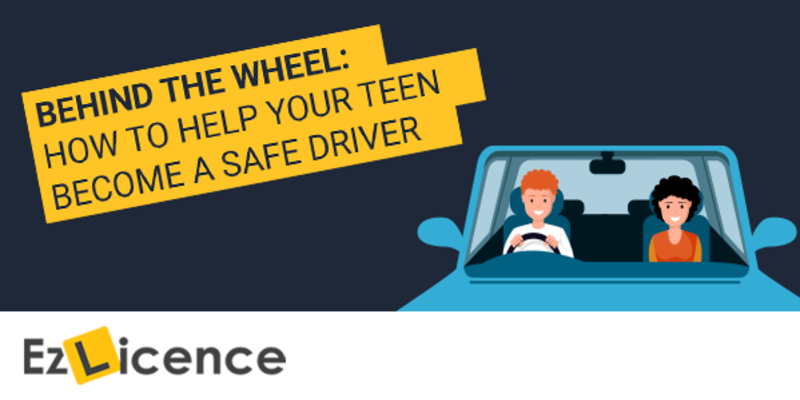Behind the Wheel: How to Help Your Teen Become a Safe Driver
Last updated 20 Sep 2024

Every learner driver is different, but they all need to learn and master the same skills, behaviours, and knowledge required to drive safely on the road in traffic. They will need to record up to 120 hours of driving with an appropriate supervising driver - exact hours required will vary by state, be sure to check the requirement with your local road authority.
Instructional driving lessons will be taught by a qualified driving instructor, but most recorded driving experience will be supervised by a parent. Naturally during this learning experience there will be a lot of lessons, mistakes, questions, and frustrations, but a good plan and safe driving tips can help.
In this article we’re going to look at some tips to help give your teen safe driving behaviours.
Starting slowly
Your teenage learner driver doesn’t have any real experience with driving yet, and not many parents have had previous experience supervising a learner driver. It’s important to begin slowly, planning driving lessons in quiet locations free of traffic so you can focus on the basics together.
Empty parking lots after hours are great for the very first lessons you have together. They allow you to practice the absolute basics without the pressure of any traffic or road conditions. Here they can focus on the basics such as stopping, starting, steering, and checking their mirrors and blindspots without the pressures of other traffic.

When it’s time to move on to driving in traffic, a gradual transition to quiet or empty backstreets close to home will ease your learner driver into the experience with light traffic. Allow your teen some time to become confident driving around quiet traffic here before moving onto main roads - it’s not a rush, and throwing them in the “deep end” is only going to harm their confidence and could put you and your learner or other drivers at risk.
Quiet backstreets and parking lots are also great for experiencing new driving conditions. Give your teen safe driving tips for winter, and then head to a carpark to practice in wet weather conditions. This will let them experience the difference in braking and tire grip, while reducing the risk of accident compared to driving on a road.
Building confidence
You should try and arrange driving lessons with a qualified driving instructor as early as possible. After the first few sessions driving together your learner driver should have the basics down, and you should have an idea of how to structure your driving practice with them.
It’s important to practice just a few new skills or pieces of knowledge at a time. Trying to practice too many skills at once can be confusing and overwhelming, and expecting them to spread their attention across several new things may make it difficult to learn, or cause them to develop bad habits.
Likewise, attempting to force them to drive in situations where they aren’t comfortable or prepared (such as taking a first driving lesson on a busy highway) can create a serious risk of accident if they become panicky or are unable to make the appropriate judgements of timing and positioning.
You should avoid making any comparisons of their progress against the progress of other learner drivers, and try to help them focus on their own progress. Learning to drive isn’t a race, and it doesn’t matter if it takes them more or less time than anyone else when learning to drive. The end goal of driving lessons is to help teach your teen safe driving behaviours, and ensure they have the knowledge and skills to survive on the road.
Also, remember to be patient with your learner driver. The advice you’re giving may seem intuitive and simple, but you’ve had years of practice and experience at driving - your learner driver is experiencing many things for the first time, and often learning several things at once.
As a parent you are the primary role model for your teen while driving, and you must demonstrate good driving behaviour and etiquette every time you drive. This not only means constantly checking blindspots, indicating appropriately, obeying speed limits, and driving with consideration of other road users.
It also means putting anything that may be distracting (including phones) in your glovebox or other location where they will be out of sight, and always remaining calm while driving - even when other road users are doing the wrong thing.
Developing skills
Driving lessons with a qualified driving instructor aren’t meant to completely replace the time spent driving with a parent (or other supervising driver). They are meant to help the learner driver learn the specific skills that need to be developed, and to fill any knowledge or skill gaps, and establish safe driving strategies.

Driving instructors aren’t just good at teaching learners how to drive, however. Because they have experience in teaching a wide variety of people ranging from fresh beginners to experienced drivers in need of refresher lessons, driving instructors are also a great source for the best safe driving tips for new drivers in the local area. They know how to teach the most effective teen safe driving behaviours, and can provide tips on safe driving that’s relevant to your city or town.
In between structured driving lessons, you should encourage your learner driver to make the most of any opportunities to drive that are available. As they become more competent at handling the car and following road rules, you should begin to practice driving in areas with unfamiliar new terrain and conditions. Doing this slowly allows them to become familiar and confident with learning to identify hazards.
For example, you may choose to have your learner driver drive along a quiet portion of local highway (with easy entry and exit) for 5 minutes at a time, only after they have become familiar with driving on busy roads in your local area. This allows them to experience the high volume of traffic and you can highlight a few key examples of potential hazards without overloading them. At this point, it’s a good idea to give them safe driving tips for winter when wet weather conditions are likely to be slippery and obscure vision, both of which will require them to adjust the way they drive accordingly.

While taking your teen out for driving lessons, it’s important to ensure that they do not use their phone or any other device while driving. However it can be beneficial to avoid using devices yourself while supervising them - especially when you are both starting out with driving lessons. Until the learner has mastered hazard perception and general road awareness skills, it’s important to provide them with the support and security of your own attention. Thanks to years of driving experience, you may be able to identify hazards that they haven’t even considered - if you are also watching the road and not looking at your phone.
Becoming a P-Plater
As your learner driver prepares for their driving test, you should help them practice skills likely to be assessed during the test.
This is also a good time to practice scenarios where they may be forced to suddenly stop - such as if their windshield is broken or their tire becomes flat. This does not require you to physically experience either of those - tell them “your window is broken, come to a stop” and have them practice the appropriate response.
After your teen has achieved their probationary (also referred to as provisional or “P” plate) drivers licence, it’s still important to support them as they transition from a learner into an independent solo driver. The first six to twelve months after becoming a P plated driver is the period of time when a young driver is most at risk of a serious accident resulting in serious injury or death.
There are some steps you can take to ensure they observe safe driving habits as a solo driver, such as placing curfews or restrictions on driving allowances. While it can be a very liberating feeling to finally have the licence to legally drive without supervision, you should discuss setting limitations on solo driving in the early months, removing limitations over time as they gain experience driving solo.
Examples of limitations that you may be able to discuss with your teen include:
- Only driving for work, sports, or education commitments
- Only driving to locations 10 minutes or less away
- No passengers (unless you are supervising)
This list is only meant to provide a few examples however, and these suggestions will not work for everyone or every situation.
Hopefully you’ve found some of our safe driving tips for new drivers to be helpful.
With the EzLicence platform driving lessons can be booked online in 60 seconds or less and managed through your own private booking portal. Driving lessons have never been easier to manage for learners or parents!
To get started, enter your postcode in the instructor finder form below to compare the range of driving instructors available in your area, and make a booking today.

About the author
The EzLicence online platform brings transparency, choice and efficiency to booking and managing driving instructors and driving lessons in Sydney, Melbourne, Brisbane, Perth, Gold Coast and Sunshine Coast.